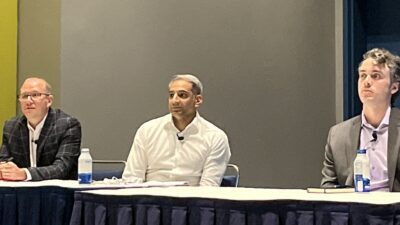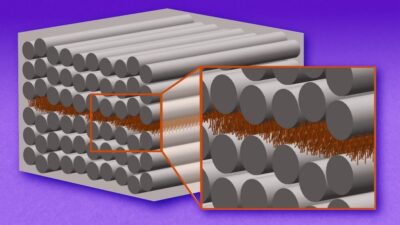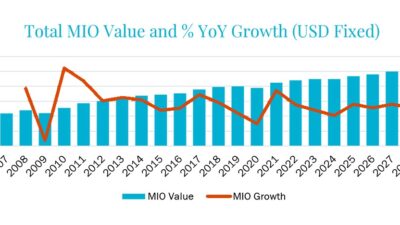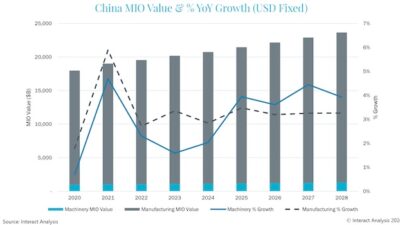When General Motors set out to establish a global conveyor platform in 2002, the objectives were clear: accommodate faster production changes, lower costs, and simplify installation and maintenance. The solution needed to work in new plants as well as retrofit installations. Technologies selected for the solution are said to be winning converts at GM plants around the world.
AT A GLANCE
Gear motor, drive, safety circuit
Flexible, modular designs
Decentralized control
Simple setup
When General Motors set out to establish a global conveyor platform in 2002, the objectives were clear: accommodate faster production changes, lower costs, and simplify installation and maintenance. The solution needed to work in new plants as well as retrofit installations. Technologies selected for the solution are said to be winning converts at GM plants around the world.
For Hans Rodgers, senior manufacturing project engineer for GM’s Controls, Conveyors, Robotics and Welding group, the beauty of the integrated conveyor controls developed by SEW-Eurodrive was simplicity. The system consists of highly modular elements, including integrated gear motor, drive, and a separate 24-V dc safety circuit fed from a safety relay. No wire termination or programming is needed, yet the system offers simpler, faster installation for on-site electricians and the ability to use standard conveyor modules.
SEW’s conveyor-control system has given assembly plants increased flexibility, allowing production line changes for different vehicle bodies in days instead of months. It has enabled GM to achieve significant savings in engineering and installation costs. Savings come from fewer components, less wiring and maintenance needed, plus eliminating lost production time from nuisance E-stops. Savings can amount to $1,000 per drive in a plant.
“We build similar body styles around the world,” explains Rodgers, “however, in many cases the local plant was constantly ‘re-inventing the wheel’ when it came to designing vehicle conveyance equipment. Now we have a control system that is simpler and less costly to engineer and implement, whether the facility is located in North or South America, Europe, or Asia. It’s what we call standardized flexibility.”
With that flexibility, GM has standardized on a few different conveyor modules for most of their vehicle production. Ability to deploy common manufacturing equipment architectures is essential to driving unnecessary costs out of the manufacturing process.
Decentralized control is key
Simplicity is in the engineering: SEW’s control is decentralized with an integrated drive and gear motor housed on conveyor modules. Besides decentralizing the control system—which dramatically cuts field wiring—new plug-and-play SEW modules (dubbed “connectorized” units) eliminate field wire terminations. Even in locations like China, where labor is less expensive, GM engineers are confident the connectors will deliver significant savings in personnel. In addition, the move has minimized the number of wiring errors, a recurring cause of start-up delays at any manufacturing plant.
Dual inline package (DIP) switches instead of software configure the drives. It proved to be the lower-cost design by eliminating the need for programming software and associated training. Keypads, laptops, and other peripherals also could be kept out of the mix to streamline setup and maintenance tasks of line personnel. “Sometimes low-tech is best-tech,” says Tom Curtin, SEW’s automotive segment manager. “Once you understand how the drive needs to control the motor, there’s no need to program each individual drive. With SEW making both the drive and motor, DIP switches made it easy to standardize motor control.”
And the 24-volt safety stop circuit integrated into the drive replaces traditional safety hardware components. This combination of design decisions helped eliminate local engineering and installation variations, making a global platform possible.
Eliminate costly contactors
SEW’s design allowed GM to eliminate use of costly safety contactors—necessary in a traditional safety design—without compromising worker safety. Instead, a 24-V dc safety stop (EN954-1 category 3) is implemented through a low-voltage approach that separates the safety function from line voltage power used to control the drive and motor. When needed, the approach disconnects the 24-V dc safety supply to prevent the firing of power transistors in the variable-frequency drive, placing the controlled motor in a state that cannot develop torque—although the 480-V supply is still present.
Because the safety stop is on a separate circuit, it halts conveyor motion without cutting power to the control system and drive. Important to end-users is that the conveyor system can be quickly restarted after the safety condition is cleared. With a traditional in-line installation, an entire circuit of drives could be disconnected from the host controller in the event of a safety stop. After an E-stop, the sequence to restore power must be very carefully followed to prevent damage to the drives. Quickly turning power off and on can be dangerous and shortens a drive’s life.
“GM wanted a standard safety architecture, so that if one component fails, an E-stop is pressed, or a light curtain is breached, an employee would not be at risk,” explains Curtin. “Our safety controls not only fit that template, which allows GM to determine what events will trigger a safety stop, they have saved the company millions of dollars. A typical plant uses a thousand or more safety contactors. We’ve been able to cut their costs by at least 60% using a simpler, less expensive design.”
With more than 5,000 new SEW conveyor-control systems installed at GM plants worldwide, Curtin has high praise for GM’s technology planning and forward thinking. “We’ve gained an appreciation for the difficulties of global change from working with GM,” he says, “They make technology changes in steps, like climbing stairs. They understand how difficult change is for the local plants, so they take one big step at a time rather than constant small ones. Common systems can also be supported globally by technical resources from multiple regions.”
It’s an approach to technology advances that fits well with the SEW model, says Curtin. “Our products are modular, and we make the same products worldwide, which we use to develop a custom solution. Once we understand how the customer needs a solution to work and we’ve fine-tuned the engineering, we can then replicate it for that customer and others with similar needs anywhere. It’s standardized flexibility at work.”
Attesting to the integrated conveyor control system’s practicality, SEW’s approach also is at work in facilities of competing automotive manufacturers.



